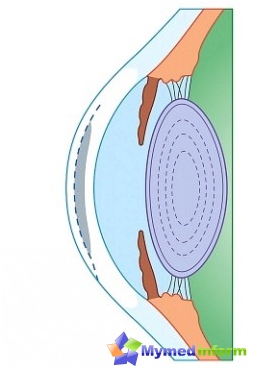In myopia, the image accounts for at all on the installed retinal area, on the contrary, it is located in the plane that is in front of it. That is why people with myopia perceive the surrounding items fuzzy. All this is due to the fact that there is a mismatch of the power of the optical system with a length. Most often in myopia there is an increase in the eyeball (the so-called axial myopia).
Myopia and its types

Myopia is congenital and acquired. At the same time distinguish myopia:
- Early acquired (pre-school age).
- Acquired at school age.
- Late acquired (adults).
Myopia, everything else, can also progress. Myopia is most often evolving due to three factors: a person performs visual work at close range, heredity and due to the weakening of the outer shell of the eye. In this case, the task of the doctor to determine which of the above factors is fundamental and affects the development of myopia to correct the treatment and eliminate these reasons. In this disease, a person can see perfect near, but with the subjects at a distance much more difficult.
In fact, this is a rather serious illness, since in myopia, a person can just just on time «miss» DANGER: Outdoor hatch or approaching transport.
Degrees of myopia

Children have a visual system all the time in development. Appearing on the light, the kid can not boast of sharp vision, and he also has no connection between the right and left eye. Adult, baby acquires a more advanced visual system. Parents are very important to ensure that the vision does not decrease in preschool age.
To protect the baby, our site strongly recommends that he spends smaller time at a computer or a TV. If suddenly the vision began to deteriorate, it is worth visiting a doctor, as it may be a accommodation spasm. In the future, it can go into progressive myopia. Experts argue that the most serious disease is amblyopia when the vision decreases, despite the fact that man wears glasses.
Mostly progressive myopia occurs at school age when children are actively growing. At the same time, the number of guys who fall vision annually.
It is also worth noting that there is a false myopia - when the age of four-six years old has an excess accommodation voltage begins. There are several periods when parents need to be very attentive to the vision of the child:
- When a child goes to first class. Today this period affects age from five to seven years. The beginning of study is not only agreed, but the reason to carefully take care of health.
- Transition from the younger school in the middle. This age, about ten and twelve years, is very important, as puberty begins. Hence the transitional age and emotional-unstable behavior.
- End of senior school. Fifteen-Seventeen years: Time exams, prom and student life.
These three periods may be accompanied by the same symptoms: headache In the evening, fast fatigue, after eye tension (reading, watching TV, computer work), appears «Pain in the eyes» - So children call fatigue and overvoltage of eyeballs. All this is very dangerous symptoms, since after them children often begin with vision problems: in particular, its acuity is noticeably reduced.
Today developed a variety of treatment of myopia. In addition, there is a preventive charge, which is advisable to perform several times a day. Experts even invented a computer program that can train vision.
Correction of myopia
To adjust bad vision, in particular, myopia, today is possible in two ways: wearing glasses and wearing contact lenses. With the help of these optical devices it is possible «force» Align light rays and make sure that they intersect exactly where they should - as in people who have one hundred percent sight. Unfortunately, no glasses or contact lenses will never get rid of myopia. They can only improve vision for the time of wearing these devices, no more.
Currently myopia is healing. Today there are already more than twenty methods of treatment of myopia.
Treatment of myopia

Despite the fact that there are many methods for treating myopia, there are some ways that have proven themselves exclusively on the positive side. To them and resort most often. Here are five of the most famous methods:
- Correction laser. The most efficient, popular and secure method. It is resorted to it not only in myopia, but also with farnicide, and astigmatism. Vision is corrected by changing the shape of the cornea with the help of a laser beam. In principle, the procedure is simple, it is performed only in a few minutes. With this method, you can eliminate myopia even to 15.0 diopters. Laser correction is allowed to people aged 18 to 45 years, but the final decision takes an ophthalmologist.
- LensEctomy. With refractive replacement of the lens (LensEctomy), the doctor removes a transparent lens, and places an artificial lens on its place with the desired optical force. This method is used to treat myopia to 20 d. This operation is carried out mainly when a person cannot clearly distinguish the items that are located from it at different distances. LensEctomy is a more complex operation, but it takes no more than 20 minutes.
- Lenses implantation. Thanks to implantation of actual lenses, it is possible to cure myopia even up to 25 diopters, while the lens itself will remain in place, but in the eye chamber (either the back, or front) will be put a special lens.
- Radial keratiac. With the help of small radial cuts, the shape of the cornea is changed, as well as its optical power, which subsequently improves eyesight. In this method, many minuses, among them: the duration of the reducing period, an unclear results forecast, the likelihood of complications during exercise and T. D.
- Keratoplasty. With this operation, the cornea plastic is performed, which affects improvement. This result is achieved through the transplant of the donor cornea (more precisely, its defined layers), and then its simulation.









